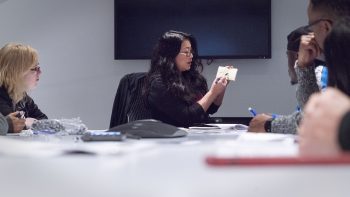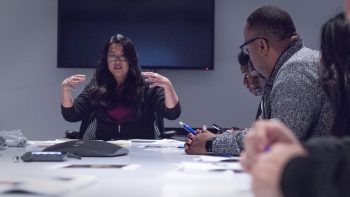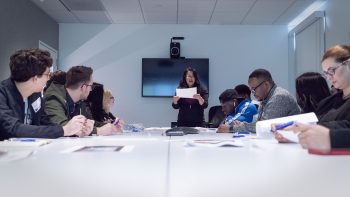Sony Animation is set to release the Academy Award winning Spider-Man: Into the Spider-Verse on digital February 26, 2019 and on blu ray March 19, 2019.
Last week our own Ashley Victoria Robinson was invited to the studio to interview many of the creative forces behind this major motion picture and some of the special features that will be appearing on the blu ray – including Denise Koyama, Story Artist on Spider-Man: Into the Spider-Verse.
DENISE KOYAMA: I’ve been doing storyboard now for, I think, about 28 years. Storyboarding is the first step  to visualizing the script. The director will break up the script into 3 – 5 page sequences and then hand out the sequences to the artists depending upon our skills. Some people are good at drama. Some people are good at comedy. Some people are good at action. In Spider-Man we get to do everything. It was a lot of fun!
to visualizing the script. The director will break up the script into 3 – 5 page sequences and then hand out the sequences to the artists depending upon our skills. Some people are good at drama. Some people are good at comedy. Some people are good at action. In Spider-Man we get to do everything. It was a lot of fun!
Our story process here at Sony is to prepare for the project by doing research, then we’ll get launched on a sequence, we’ll do preparation for that sequence before we even draw, and then we’ll finish the drawing, finish the sequence, pitch it to the director for approval. If it gets approved it goes over to editorial. They’ll put it together in an animatic. That process will repeat itself until the end of the film or we run out of money.
The first part is research and there is no better research than doing comic books. We get to read comic books, watch movies. This is such torture! (laughs) But, I haven’t read a Spider-Man comic in – I was really inspired by Spider-Man when I was a kid. I read a lot of Steve Ditko’s Amazing Spider-Man. Great drawings. Great flow to the characters. A lot of fun. Really human situations and that’s what really attracted me to that. I stopped reading comic books maybe around the year 2000 and, so doing research on this project was like, “Oh my gosh! There’s a giant Spider-Verse! It’s not just Peter Parker!” There’s Gwen. There’s a person of colour! You don’t even have to be human – Spider-Ham! I did not know that there was a real Spider-Ham until I did some research.
The first thing that we’ll do is that we will take the script and we’ll read the whole thing. Now, for me as an artist, this is the hardest part of the whole process ‘cause I don’t read good. (laughs) But, what was great about this project was that it was so good. The writing was so amazing. So, we’ll make some notes about some sequences and we’ll present it to the director later.
The next step is to study the characters and not just how to draw them, but what their personalities are, their backstories, figure out any little quirks that they have. My favourite is Jefferson. He’s a real superhero to me because he’s powerful and he doesn’t have any super powers, but he just goes.

… Next we’ll study the environment and different locations. They have a really amazing New York City. I did some studies of New York City, myself. Checked out a lot of Youtube videos. (laughs) And then we’ll get the Colour Script. This is the colour to accentuate the mood of each sequence and, so if we get a certain sequence and it’s dark, or it’s light, we know to keep the tone up or the tone down or make it serious – not a comedy moment if it’s dark and brooding.
[With] the glitching in the multiverse, we have to draw those in a single drawing and not make it – how are you going to draw that in one drawing using Sharpie and Post-Its? It’s crazy! So, we had to sit down and do [hard work].Justin [K. Thompson, production designer] did some initial sketches in pencil of how he wanted the collider to look and, then … colour studies of how it ended up. There are several – several – layers. So, for myself, how to present that? For the glitching I used a bunch of different filters to show, in a still image, how that glitching is going to look.

… Next comes the actual sequence launch and they’ll give me 3 – 5 pages, I read it, we’ll all sit together – the directors, the writer, the head of story, and the story artist – we’ll sit together and read through the actual script, acting out how we want the the characters to go. If there’s any kind of glitch or anything we’ll talk about it. If there’s any ideas that come up we’ll talk to each other. Sometimes in Spider-Man it was such a crazy, crazy schedule that they’ll come up with ideas left and right. They’re just amazing at coming up with ideas. They might give you a script and suddenly it’s like, “Forget it! Here’s this idea instead.” and then they’ll pitch you the idea and then you’re like, “Okay!” and do it. Sometimes you get very simple [changes].
… [Then you] start drawing. Every single time I do this, no matter what, I feel completely terrified. How I usually start is to do little thumbnails and take little Post Its and a Sharpie and block out and this way you can do things very, very quickly – make changes very quickly, cut and paste how you want – and then it’s completely illegible to everybody but me. (laughs) It helps. Then I’ll take a programme – I use Photoshop, some people might use TB Paint or Storyboard Pro – and I’ll draw out the panels and, then I’ll in put those panels into our proprietary software … Flix and Flix is really great because it makes communication between the departments from Editorial, Story, and the Director seamless and instantaneous. So, say that I’m off-location and drawing at home. I do the sequence, I input it, and instantly the director can see it, make changes, give me notes, send it to Editorial. Editorial will download it into Avid, cut it, make it into an animatic, and get back to me. That happens on a daily basis, so the pace is very, very fast. A long time ago you had maybe 3 – 4 weeks on one sequence. We would have two days.
Then comes the pitch. Once your finished with the sequence you go to the directors and you say, “Let me pitch it to you.” I’ll act out the dialogue or tell you what’s going on and, then you get the thumbs up or thumbs down. Hopefully you get the thumbs up and you can relax a little bit, but if not, you repeat that whole process over. Once you’re finished and it does get approved it goes to Editorial and you’ll keep doing this process until the end of the picture or we run out of money.

Dear Spoilerite,
At Major Spoilers, we strive to create original content that you find interesting and entertaining. Producing, writing, recording, editing, and researching requires significant resources. We pay writers, podcast hosts, and other staff members who work tirelessly to provide you with insights into the comic book, gaming, and pop culture industries. Help us keep MajorSpoilers.com strong. Become a Patron (and our superhero) today.


